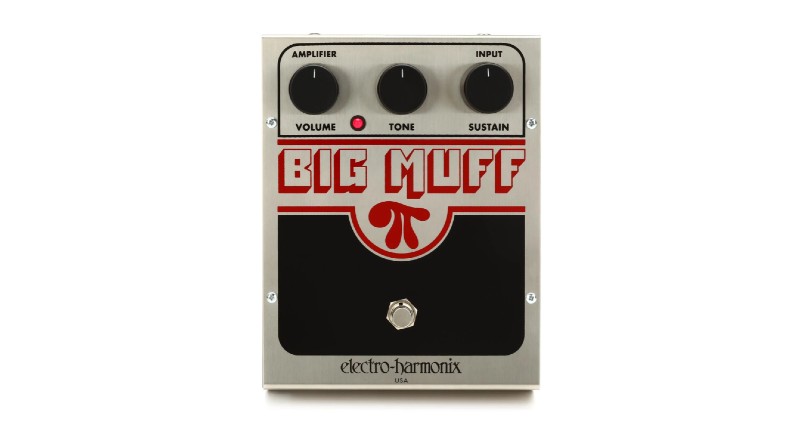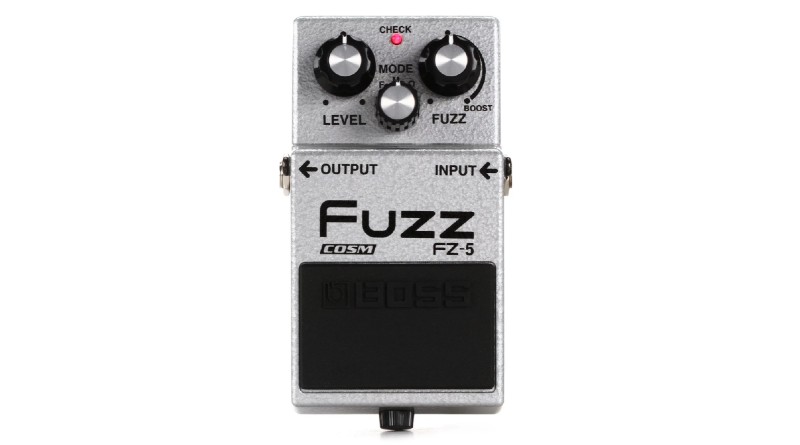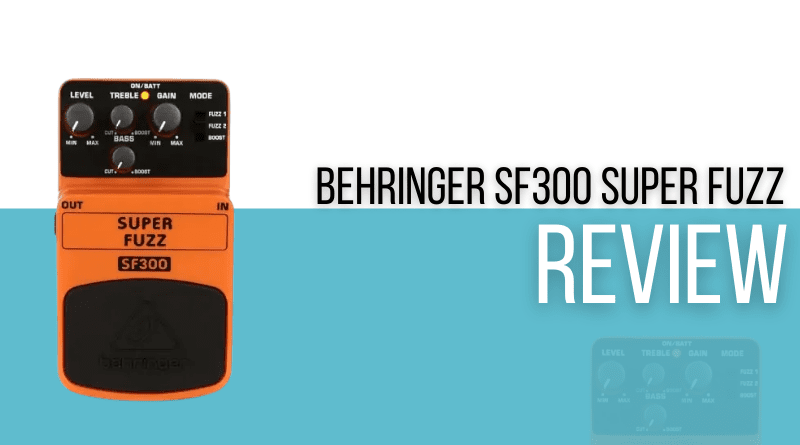Behringer has made quite a splash in recent years, having gone from relative obscurity to being absolutely everywhere. They have bombarded the market with affordable gear for every player, particularly their budget pedal range, including this offering, the SF300 Super Fuzz Pedal.
On specs alone, the SF300 Super Fuzz looks like the perfect pedal to fill the void left by the legendary Boss FZ-2 Hyper Fuzz, but can it live up to the legacy? Keep on reading to find out.
Read more about our review process.
Contents
Behringer SF300: Who Is this For?
The Behringer SF300 Super Fuzz is really aimed at guitarists of all levels. Because of the extremely low price, it’s accessible for new to intermediate players who want to dip their toes into the world of effects by building their own pedal board, rather than just buying a multi-FX pedal.
The Super Fuzz is also perfect for the working musician, somebody who has been playing a long time, gigs regularly, and recognizes that a big brand name is far less important than price and performance. Seeing as this Behringer pedal is available for an absurdly low price, and has the features of a much more expensive model, you can certainly see why it has such widespread appeal.
Behringer SF300: Appearance / Features / Controls
The SF300 Super Fuzz is built in the same plastic chassis as most of Behringer’s pedal lineup. This model in particular is finished in a bright orange hue – it looks great, and we found that the construction was actually pretty sturdy. Even if it were to break, at the price, you could buy 6 or more of these for the price of a single Boss FZ-2!
If you’re not completely familiar with fuzz, a simple way to think about it is as an effect that turns the curved sound wave produced by your guitar into a squared off wave, which has the ultimate effect of making your amp sound broken, in a good way.
For convenience, this pedal can run on a 9V battery, or it can run with the Behringer PSU-SB DC power supply (sold separately). We ran our test using the battery, and it worked perfectly. There’s no quoted battery life from Behringer, but we still had full functionality after over 8 hours of use. There’s also a handy battery life indicator LED, so you’ll know when it’s time to change ahead of time, rather than discovering this on stage during a performance.
As for controls, you’ve got rotary dials for level, gain, treble, and bass. The level control adjusts the volume output from the pedal. The gain knob controls how much fuzz the pedal creates, taking you from clean to fully clipped. The bass and treble dials give you active EQ for adjusting the tone’s bottom and top ends, letting you customize each fuzz mode.
There is a three position switch for the fuzz modes, labeled simply as Fuzz 1, Fuzz 2, and Boost. We’ll cover more on what each of those functions do in the performance section.
Behringer SF300: Performance/Sound
We didn’t know too much about this pedal before we got our hands on it. Specs-wise, the Behringer looks to be inspired by the legendary (and discontinued) Boss FZ-2 Hyper Fuzz, so we were quite excited to get hands on with it.
This pedal is loaded with 3 different fuzz modes; Fuzz 1 is for classic fuzz, which we found to be very Hendrix-esque in tone. We started the test with the bass and treble active EQ at noon to get a good picture of the base sound – in this setting the tone was very mids focused.
Fuzz 2 was more of a contemporary, grungy fuzz – we loved this setting for getting everything from a ‘90s Seattle sound, through to an all out doom metal tone. In this setting the pedal is very mids-scooped, giving you all the bass and treble. This setting is perfect for playing rhythm in a band as it allows the lead to cut through while still retaining presence.
The third option is level booster, which really helped us to push the amp into an ear pleasing breakup at bedroom volume levels, and when cranked gave us some massive crunch.
As mentioned above, it is made with a plastic chassis, which isn’t typical for pedals, but in reality, we found that it was more than up to the task. The plastic used isn’t flimsy at all, and has an ABS type of feel, so it should be pretty resistant to impact (this is one thing we didn’t want to try!). The pedal is protected with a durable rubber pad, and the hinge action was firm, without being stiff. Obviously, we had some reservations to begin with because of the plastic, but once we’d spent some time looking it over, we got over the concerns and truly enjoyed playing with this pedal.
One minor complaint we had was the accessibility of the battery compartment. It wasn’t particularly easy to get into. Of course, this isn’t a deal breaker as we’d normally hook up to DC on our own pedal boards, but it’s definitely an area of design that could be improved upon.
Other Fuzz Pedals to Consider
If you’re still not convinced by the Behringer, there are still some great options from more well established pedal makers that will get you similar results.
Electro-Harmonix Big Muff Pi Fuzz

The Big Muff Pi fuzz Pedal is an industry favorite. It’s a stomp box style unit that is renowned for enormous sustain and incredible fine control over the distortion. This model was a favorite of Hendrix, and is still used by Carlos Santana.
Boss FZ-5 Fuzz

The Boss FZ-5 Fuzz is the unofficial replacement in the Boss lineup for the FZ-2. Like its predecessor, it has 3 fuzz modes, as well as boost and level controls, but it does lose some functionality (namely the active EQ). Despite this, you’re getting a quality Boss pedal, built to last with a metal chassis.
Final Thoughts on the Behringer SF300
For little more than the price of a pizza, the Behringer SF300 Super Fuzz gives you a bona-fide, full function fuzz pedal. At the price, you could definitely consider it a throw away, but after hearing it, we’re pretty sure you’ll be leaving it on your board full time. It offers excellent control over the FX, and sounds like a way more expensive model. If you don’t feel like throwing $300+ at a used FZ-2, it’s great to know that you can get all of the same functionality with a Behringer SF300 Super Fuzz for a literal fraction of the price.
Check out these other articles you might like:


